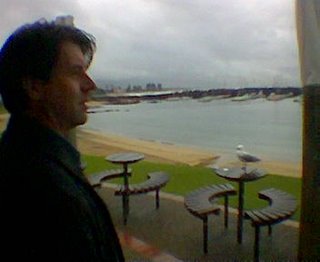Ready, FIRE, Aim

BE WARNED.
What happens if you go to the shops too fast in Iraq.
What happens if you go to the shops too fast in Iraq.
Another case in the news today of one of these "US checkpoints" in Iraq shooting first and asking questions later. Reporter Giuliana Sgrena was released by Iraqi kidnappers, then was shot upon her exit by the very same force that is supposedly spreading peace and democracy in Iraq.
Much like the example in mid-January where a young families parents were killed, there appears to be conflicting stories of what actually happened.
This is how the incident is being reported by the American ABC news
By 8:55 p.m., according to a statement from the U.S. 3rd Infantry Division, "U.S. soldiers killed one civilian and wounded two others when their vehicle traveling at high speeds refused to stop at a check point."
Sgrena's boyfriend, Pier Scolari, said she told him that the car wasn't speeding. Sgrena subsequently told interviewers the car was traveling at "regular speed."
The U.S. military said the Americans used "hand and arm signals, flashing white lights, and firing warning shots" to try to get the car to stop. But in an interview with Italian La 7 TV, Sgrena said "there was no bright light, no signal, and at a certain point, from one side, a firestorm erupted."
When The Associated Press in Baghdad asked the U.S. military to see the vehicle on Saturday, the military said it didn't know where it was.
Unanswered questions:
How many people were wounded? The Americans said two civilians: Sgrena and an intelligence agent. Italian authorities said two agents were wounded besides Sgrena. Italian military officials declined to clear up the discrepancy and Berlusconi's office did not respond to a request for information.
Looking around for a an Iraqi Checkpoint photo. I came across this website. It describes what seems sensible way to set up a checkpoint if you are are an occupying army. There have been three instances that I can recall of a vehicle failing to slow down and the innocent occupants being killed. Bad press city.
What seems to happen is someone (US army cowboys) start firing at someone (Iraqi Mum and Dad in a Toyota Tarago), in a split second Dad has to decide to get away or stop. Some of these get reported if there are journalists around. But being a journalist is a risk in itself with about 70 killed by US forces so far.
The below seems to be a preventative way of doing this by creating a chicanes, speed humps etc . This one is a larger more permanent structure, however some of the key concepts could be utilised to prevent the onset of "friendly fire" and really esatblish an air of authority.
Hey...... and another positive, it adds to the the economy as more tax dollars go towards creating "Peace in Iraq".
Vehicle Checkpoints
1) Vehicle check points present many dangers and there is no foolproof method of eliminating all dangers. Here are some of the problems: a) People driving straight through on purpose, perhaps using weapons, putting VCP staff, passing public as well as themselves in danger. b) Suicide or other car bombers intending to stop with the same dangers. c) Innocent persons accidentally driving through and being killed or injured by VCP obstacles and/or by VCP staff, with very bad effects for the victims, for the in Iraq and Worldwide publicity and for morale of VCP staff. d) People of evil intent being able to see staff routines and the methods of checking, and discovering weaknesses, and thus reducing the value of the VCP. e) Long hold ups, dismaying road users and causing bad publicity. f) Difficulty prioritising vehicles to be searched. g) Apart from the above, the difficulty of actually training the staff and doing the checking and running the VCP.
2) Defence-Structures Vehicle Check Points can offer some remedies to some of these problems. It should not surprise anyone that the end result is like a motorway fuel station, or an efficient cross border customs post.
The checkpoint must provide:a) A labyrinth forcing at least 2 sharp changes of direction which have to be taken slowly. b) The straight-on route has to be very clearly seen to be impassable, by day or night, with no by-pass. c) The route through has to be divided into several lanes, as many as needed to keep the queues down. d) Each bay needs an easy way of preventing vehicles from leaving; chain hedge hogs can help here. The exit must also have a gate covered by observation posts and the rapid reaction room. e) Each bay should be separated by cover from view screens or blast walls, depending on the threat. f) Each bay must be observed by a sangar which either covers the bay with armed equipment or at least appears to, as well as the 1 or 2 vehicle checkers per bay. g) The VCP should provide secure and comfortable accommodation, rapid reaction guardroom, observation posts. h) The normal security systems are needed, depending on the perceived threat, as well as grillage floors. i) Steel road bumps discourage high speed. j) An overall roof provides weather protection.
This is sooooooo sensible if you think that an occupying foreign army, has the right to stop, search and shoot ANYONE when they go down to shops to get some bread and milk. The point being there should be no bloody checkpoints in the first place.


0 Comments:
Post a Comment
<< Home